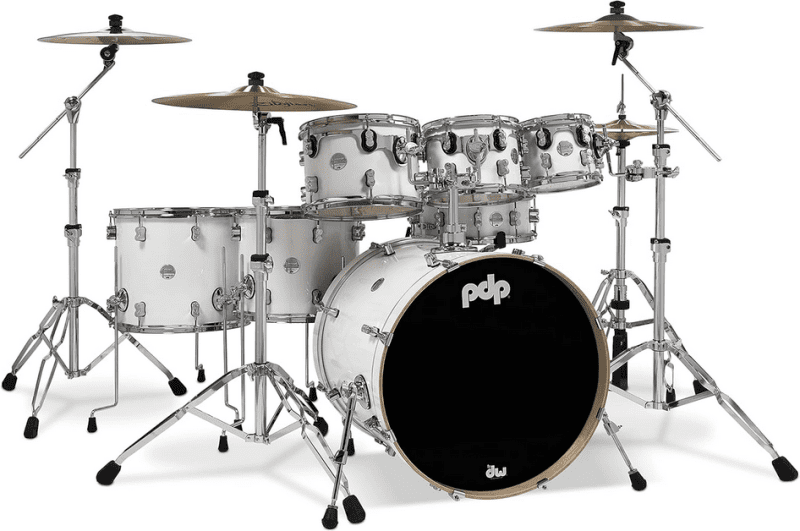Master The Basics: Beginners Drumming Lessons Made Easy

Starting out on the drums can feel overwhelming, with all those different parts and rhythms to master. Did you know that with the right guidance, even total beginners can lay down a solid groove? Our blog is your go-to for breaking down drumming into simple, manageable lessons that will have you rocking in no time.
Dive in and let's hit it!
Key Takeaways
- Drum lessons start with the basics, such as holding sticks and understanding the parts of a drum set. They then move on to more complex skills.
- Online resources like Drumeo offer step-by-step training and interactive tutorials for beginner drummers.
- Practicing regularly with a metronome and playing along with music can improve timing and technique.
- Reading drum notation is key to learning new beats and fills, while video lessons can demonstrate proper techniques.
- Warm - ups, practice routines, and recording sessions help beginners see improvement in their drumming skills.
Understanding Drum Lessons for Beginners

Diving into drum lessons as a beginner can be both thrilling and challenging—there's a whole new language of rhythm to learn. Knowing the process, from grasping the basics to mastering simple beats, forms a solid foundation that every novice drummer needs for success.
Importance of Drum Lessons
Drum lessons give you the power to hit the right beat every time. They help you learn how to hold drumsticks correctly, whether it's traditional grip or matched grip. You'll also get the hang of different drum beats and fills that are essential for any song.
With guidance from skilled teachers like Jared Falk and Lionel Duperron, beginners can master basic techniques faster.
Knowing how to tune your drum kit is an important skill taught in these lessons too. They cover everything from bass drums to hi-hats, making sure each part of your set sounds perfect.
Plus, they guide you through tricky parts like double strokes and maintaining a steady tempo. Good drumming isn't just about loud noises; it's about control and rhythm, which these lessons aim to instill in every learner.
Different Stages of Drumming Lessons
Drum lessons are the foundation for every drummer. They guide you from the basics to advanced skills.
- Stage 1: Getting to Know Your Drum Set
- Learn each part of the drum set, including the snare drum, kick drum, hi-hat cymbal, and tom-toms.
- Understand how to sit correctly and hold your sticks using matched grips like the French, American, or German grip.
- Stage 2: Basic Drumming Techniques
- Practice key drum rudiments such as single-stroke rolls and double-stroke rolls.
- Start with simple beats and rhythms to build coordination between your hands and feet.
- Stage 3: Reading Drum Notation
- Read sheet music and understand drum tabs.
- Get familiar with music terms like time signatures and tempos.
- Stage 4: Playing Along with Music
- Play basic beats along with songs in different genres like rock music, funk, or jazz.
- Use a metronome to keep a steady time as you play beats per minute (bpm).
- Stage 5: Developing Speed and Complexity
- Increase speed with practice pads while maintaining control.
- Add more complex fills into your playing.
- Stage 6: Advanced Techniques
- Master more challenging drum rudiments such as flams and paradiddles.
- Combine different techniques into longer solos.
- Stage 7: Personal Style and Improvisation
- Experiment with creating your own beats and fills.
- Explore different sound textures with various cymbals like ride cymbals, splash cymbals, or china cymbals.
Basic Techniques for Beginner Drummers

Mastering the fundamentals can transform your drumming from shaky rhythms to smooth grooves. For beginner drummers, understanding essential techniques is like laying down a solid backbeat—you've got to have it before you can build upon it.
Basic Beat and Fill
Playing a basic beat is the heart of drumming. Learning to fill is like adding your personal touch to a song. Here's how to get started:
- Set up your drum kit properly before you play. Make sure the snare drums, bass drum pedal, and hi-hat stand are within easy reach.
- Warm - up your hands and wrists. Stretch well to avoid any injuries.
- Start with a simple rock beat. Count out loud "1-2-3-4" and hit the hi-hat cymbals on each count.
- Add the bass drum on "1" and "3". Keep counting and stay steady.
- Bring in the snare drum on counts "2" and "4". Now you're playing a basic rock rhythm!
- Practice this until you can do it without thinking too much.
- Begin with a single-stroke roll (right-left-right-left) around the drums.
- Try hitting the snare, high tom, then mid tom, in sequence. Do this slowly at first.
- Look at standard notation for drums. It tells you which drum or cymbal to play and when.
- Use basic sheet music to find new beats and fills to learn.
- Turn on a metronome. It helps keep your beats in time while practicing.
Reading Music for Drumming
Reading music for drumming is like learning a new language. You'll see lines, circles, and symbols that stand for different drum sounds. Each line on the staff matches a part of your drum kit.
The circles are notes that tell you when to hit the drums. Rests show you when to be silent. Time signatures sit at the start and they set the beat's pace—like your music's heartbeat.
Start by looking at simple drum beats in sheet music. Notice how each note lines up with a count in the measure. Drum tabs can also guide you—they're simpler than standard notation and use letters to represent each drum or cymbal.
Practice reading these basics until it feels natural to play along with them. Plus, understanding these concepts will help build your skills as you tackle more complex rhythms and styles later on!
Online Resources for Drumming Lessons
Navigating the digital landscape offers an abundance of options for beginner drummers to hone their skills. From interactive tutorials to step-by-step video lessons, online platforms provide a virtual treasure trove of knowledge, readily accessible from the comfort of your own practice space.
Drumeo
Drumeo is a powerhouse for beginner drummers looking to learn the ropes. With Jared Falk and other experienced instructors leading the charge, they provide step-by-step training that can transform you from a newbie into a skilled drummer.
Imagine sitting behind your drum kit, confidently hitting beats and fills after learning from some of the best.
Signing up with Drumeo Edge gets you into an exclusive club where daily lessons, community support, and play-along tracks are just the beginning. They even offer video reviews of your playing – it's like having a personal drum coach on call.
You'll find all of this on their platform designed to guide you every hit of the way. Plus, there are free lessons up for grabs when you sign up – perfect for getting your feet wet before diving in!
Other websites and apps
Learning to play drums is thrilling. You can find many websites and apps to help you get started.
- Free drum lessons: Look out for special offers on websites that provide free tutorial videos.
- Step-by-step training: Some sites offer structured programs that guide you through each stage of drumming from the basics to advanced techniques.
- Virtual drumming experiences: Practice drumming without a real kit using digital platforms and apps that simulate the experience.
- Speed improvement courses: Email sign-up on certain sites can give you access to methods for increasing your playing speed.
- Social media inspiration: Follow drummers like Samantha Landa on Instagram for tips, tricks, and product endorsements.
Tips for Practicing Drums
Practicing drums is vital for any beginner. Here's how you can make your drum sessions count.
- Set a daily practice time: Choose a specific time each day to practice. Stick to this schedule so it becomes part of your routine.
- Start with warm-ups: Use simple exercises like rolls and paradiddles to get your wrists and fingers ready to play.
- Focus on basics: Spend time mastering the basic beats and fills. These are the foundation of all drumming.
- Use a metronome: Keep tempo consistent with a metronome. Start slow, then gradually increase speed as you improve.
- Play along with music: Find songs in different styles like rock, jazz, or R&B. Playing along helps with timing and groove.
- Watch tutorial videos: Online resources like Drumeo offer valuable lessons. Mimic the techniques shown by professionals.
- Record yourself playing: Listen back to understand what you're doing well and what needs work.
- Practice different grips: Learn the French grip, American grip, and others. Each one gives a different sound and feel.
- Work on transitions: Practice moving smoothly between your hi-hat stand, snare drum, and other parts of the drum kit.
- Adjust your posture: Sit correctly at your drum sets to avoid strain. Good posture makes playing easier.
Conclusion
Jump into the rhythm and start your drumming journey today! With these easy lessons, you'll learn how to hold sticks, hit beats, and make music flow. Drumming opens doors to different styles – rock, jazz, or even rap.
Remember – every expert was once a beginner. Grab those drumsticks; let's make some noise!
FAQs
1. What do I need to start learning drums as a beginner?
You'll want a basic drum kit that includes cymbal stands, a hi-hat stand, and a stool. Don't forget the drumsticks! You can go for acoustic drums if you have space or electronic drums with earbuds for quieter practice.
2. Does it matter what kind of music I want to play on the drums?
Not really – whether you like jazz, heavy metal, rap, or indie bands like The Arctic Monkeys, starting with fundamental drumming lessons will help you master any genre.
3. How do I make sure my drum is tuned right?
Get yourself a drum key and learn how to adjust the tension rods around the batter head until your drum sounds just right. It might take some practice, but it's important for great sound!
4. Where should my hands be when holding drumsticks?
Hold your sticks with your thumbs and fingers making a fulcrum; let them rest comfortably in your palm without squeezing too hard. This grip helps you control the sticks better for all those cool beats.
5. Can I teach myself to read drum sheet music?
Yes! Drum sheet music shows where beats fall in relation to each other – it’s different from guitar tablature but not too tough to learn with some good old practice at home or at music lessons.
6. Is there special footwear needed when playing pedals on the drums?
Nope – use whatever shoes are comfortable! Although no specific shoe type is required, many kick pedal brands like Tama Iron Cobra are designed so any shoe works fine; aim for something that doesn't slip easily.
Recent Featured Articles:
"How to Develop Your Unique Drumming Style"
Exploring the World of Electronic Drums: Unleashing the Beat of the Future


